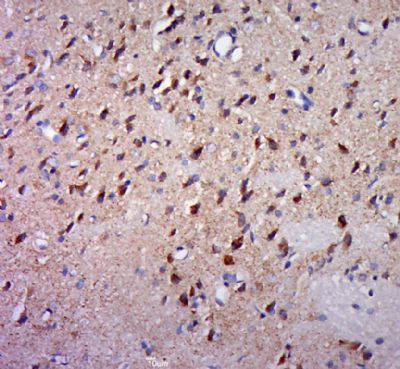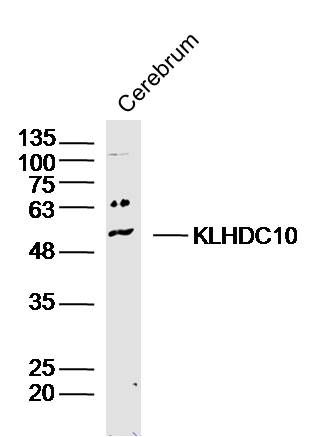KLHDC10 Polyclonal Antibody
Purified Rabbit Polyclonal Antibody (Pab)
- 产品详情
- 文献引用 : 1
- 实验流程
Application
| WB, IHC-P, IHC-F, IF, ICC, E |
|---|---|
| Primary Accession | Q6PID8 |
| Reactivity | Rat, Bovine |
| Host | Rabbit |
| Clonality | Polyclonal |
| Calculated MW | 49098 Da |
| Physical State | Liquid |
| Immunogen | KLH conjugated synthetic peptide derived from human KLHDC10 |
| Epitope Specificity | 1-100/442 |
| Isotype | IgG |
| Purity | affinity purified by Protein A |
| Buffer | 0.01M TBS (pH7.4) with 1% BSA, 0.02% Proclin300 and 50% Glycerol. |
| SUBCELLULAR LOCATION | Nucleus |
| SIMILARITY | Contains 6 Kelch repeats. |
| SUBUNIT | Interacts with CUL2, TCEB1 and TCEB2; may be the substrate recognition component of an E3 ubiquitin ligase complex. |
| Important Note | This product as supplied is intended for research use only, not for use in human, therapeutic or diagnostic applications. |
| Background Descriptions | KLHDC10 is a 442 amino acid protein that contains six kelch repeats. Expressed in fetal brain, liver, lung, kidney and placenta, KLHDC10 exists as two alternatively spliced isoforms. The gene encoding KLHDC10 maps to human chromosome 7, which houses over 1,000 genes and comprises nearly 5% of the human genome. Chromosome 7 has been linked to Osteogenesis imperfecta, Pendred syndrome, Lissencephaly, Citrullinemia and Shwachman-Diamond syndrome. The deletion of a portion of the q arm of chromosome 7 is associated with Williams-Beuren syndrome, a condition characterized by mild mental retardation, an unusual comfort and friendliness with strangers and an elfin appearance. Deletions of portions of the q arm of chromosome 7 are also seen in a number of myeloid disorders, including cases of acute myelogenous leukemia and myelodysplasia. |
| Gene ID | 23008 |
|---|---|
| Other Names | Kelch domain-containing protein 10, KLHDC10, KIAA0265 |
| Dilution | WB=1:500-2000,IHC-P=1:100-500,IHC-F=1:100-500,ICC=1:100-500,IF=1:100-500,ELISA=1:5000-10000 |
| Format | 0.01M TBS(pH7.4) with 1% BSA, 0.09% (W/V) sodium azide and 50% Glyce |
| Storage | Store at -20 °C for one year. Avoid repeated freeze/thaw cycles. When reconstituted in sterile pH 7.4 0.01M PBS or diluent of antibody the antibody is stable for at least two weeks at 2-4 °C. |
| Name | KLHDC10 {ECO:0000303|PubMed:23102700, ECO:0000312|HGNC:HGNC:22194} |
|---|---|
| Function | Substrate-recognition component of a Cul2-RING (CRL2) E3 ubiquitin-protein ligase complex of the DesCEND (destruction via C-end degrons) pathway, which recognizes a C-degron located at the extreme C- terminus of target proteins, leading to their ubiquitination and degradation (PubMed:29779948, PubMed:33909987). The C-degron recognized by the DesCEND pathway is usually a motif of less than ten residues and can be present in full-length proteins, truncated proteins or proteolytically cleaved forms (PubMed:29779948, PubMed:33909987, PubMed:39548056). The CRL2(KLHDC10) complex specifically recognizes proteins with a proline-glycine (Pro-Gly) or an alanine tail (CAT tail) at the C-terminus, leading to their ubiquitination and degradation (PubMed:29779948, PubMed:33909987). The CRL2(KLHDC10) complex is involved in the ribosome-associated quality control (RQC) pathway, which mediates the extraction of incompletely synthesized nascent chains from stalled ribosomes: CRL2(KLHDC10) acts downstream of NEMF and recognizes CAT tails associated with stalled nascent chains, leading to their ubiquitination and degradation (PubMed:33909987). Participates in the oxidative stress-induced cell death through MAP3K5 activation (PubMed:23102700). Inhibits PPP5C phosphatase activity on MAP3K5 (PubMed:23102700). Acts as a regulator of necroptosis (By similarity). |
| Cellular Location | Nucleus. Cytoplasm |
Research Areas
For Research Use Only. Not For Use In Diagnostic Procedures.

Application Protocols
Provided below are standard protocols that you may find useful for product applications.
终于等到您。ABCEPTA(百远生物)抗体产品。
点击下方“我要评价 ”按钮提交您的反馈信息,您的反馈和评价是我们最宝贵的财富之一,
我们将在1-3个工作日内处理您的反馈信息。
如有疑问,联系:0512-88856768 tech-china@abcepta.com.






















 癌症的基本特征包括细胞增殖、血管生成、迁移、凋亡逃避机制和细胞永生等。找到癌症发生过程中这些通路的关键标记物和对应的抗体用于检测至关重要。
癌症的基本特征包括细胞增殖、血管生成、迁移、凋亡逃避机制和细胞永生等。找到癌症发生过程中这些通路的关键标记物和对应的抗体用于检测至关重要。 为您推荐一个泛素化位点预测神器——泛素化分析工具,可以为您的蛋白的泛素化位点作出预测和评分。
为您推荐一个泛素化位点预测神器——泛素化分析工具,可以为您的蛋白的泛素化位点作出预测和评分。 细胞自噬受体图形绘图工具为你的蛋白的细胞受体结合位点作出预测和评分,识别结合到自噬通路中的蛋白是非常重要的,便于让我们理解自噬在正常生理、病理过程中的作用,如发育、细胞分化、神经退化性疾病、压力条件下、感染和癌症。
细胞自噬受体图形绘图工具为你的蛋白的细胞受体结合位点作出预测和评分,识别结合到自噬通路中的蛋白是非常重要的,便于让我们理解自噬在正常生理、病理过程中的作用,如发育、细胞分化、神经退化性疾病、压力条件下、感染和癌症。







